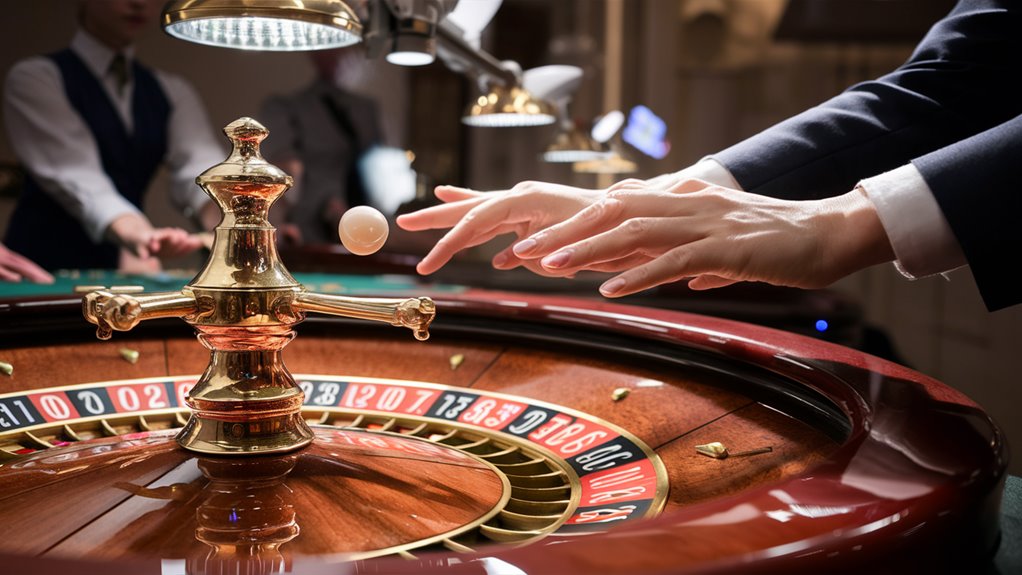Understanding Aggressive Bluffing Mistakes in Poker: Key Factors and Financial Impact
Psychological Triggers Behind Costly Bluffs
Emotional tilt and ingrained psychological biases represent the primary catalysts for aggressive bluffing errors in poker. Players experiencing tilt-induced decision making frequently engage in revenge bluffing after significant losses, while cognitive distortions lead to overconfident opponent reads and impaired strategic thinking.
Critical Strategic Errors
Poor position awareness and inadequate table dynamic analysis severely impact bluffing effectiveness. Players failing to maintain proper bankroll management find themselves making increasingly desperate plays to recover losses. These fundamental mistakes create exploitable patterns that observant opponents can leverage for substantial profit.
Technical and Financial Consequences
Inconsistent betting patterns and stack size pressure frequently expose strategic vulnerabilities in aggressive bluffing attempts. The combination of positional mistakes and emotional decision-making leads to compounded financial losses, particularly when players abandon their core strategy in favor of high-risk bluffs.
Advanced Table Dynamics
Understanding the intricate relationship between position leverage, opponent tendencies, and stack-to-pot ratios proves essential for avoiding costly bluffing errors. Successful players recognize these interconnected factors and adjust their bluffing frequency accordingly, preventing the devastating financial impact of poorly-timed aggressive plays.
Risk Management Framework
Implementing robust risk assessment protocols and maintaining strict bluffing frequency controls helps mitigate potential losses from aggressive overplay. Successful players develop systematic approaches to table selection and opponent profiling, ensuring their bluffing decisions align with optimal strategy rather than emotional impulses.
Emotional Tilt and Revenge Bluffing

Understanding Emotional Tilt and Revenge Bluffing in Poker
The Psychology of Revenge Bluffing
Emotional tilt represents one of poker’s most dangerous psychological traps, particularly when players engage in revenge bluffing against opponents who’ve recently won significant pots against them.
This destructive pattern frequently leads to catastrophic financial losses as players abandon strategic thinking in favor of emotion-driven decisions.
Warning Signs and Consequences
When affected by tilt-induced bluffing, players typically exhibit several crucial warning signs:
- Making oversized bets against demonstrated strong players
- Bluffing with marginal holdings against calling stations
- Ignoring opponent tendencies and previous betting patterns
- Increasing bet sizes beyond optimal ranges
The Confirmation Bias Trap
Confirmation bias amplifies the dangers of revenge bluffing by creating a dangerous feedback loop.
Players convince themselves their opponents must be bluffing back, leading to:
- Costly hero calls with weak holdings
- Misreading opponent ranges
- Overlooking clear betting patterns
- Compounding losses through poor decision-making
Strategic Tilt Prevention
Implementing Protective Measures
- Establish strict stop-loss limits
- Maintain detailed session notes tracking emotional states
- Take mandatory breaks after significant losses
- Focus on fundamentally sound poker strategy rather than revenge-seeking plays
Professional bankroll management combined with emotional discipline provides the foundation for avoiding tilt-based disasters.
Success requires recognizing and interrupting emotional decision-making patterns before they spiral into significant losses.
Overconfidence in Reading Player Patterns

The Dangerous Trap of Pattern Reading in Poker
Understanding Player Pattern Overconfidence
Pattern recognition overconfidence represents one of poker’s most deceptive pitfalls, affecting even seasoned players who rely too heavily on perceived opponent tendencies.
Players regularly suffer substantial losses when they become overly convinced of their ability to decode player patterns, leading to costly misjudgments and failed bluff attempts.
The Pattern Recognition Fallacy
Believing you’ve identified definitive patterns in opponent behavior – whether it’s their river betting tendencies or multi-way pot strategies – creates a dangerous illusion of predictability.
The dynamic nature of poker means that players frequently:
- Adjust their strategies mid-session
- Make unexpected deviations from standard play
- Alter their approach based on changing stack depths
- Implement counter-strategies against observant opponents
Confirmation Bias in Pattern Reading
Selective memory bias significantly impacts pattern recognition accuracy in poker.
Players naturally remember successful reads while discounting failed ones, creating an artificially inflated sense of pattern-reading ability.
This cognitive distortion leads to:
- Overvaluation of previous pattern observations
- Misapplication of historical data to current situations
- False confidence in predictive abilities
- Deviation from sound fundamental strategy
Strategic Countermeasures
To combat pattern-reading overconfidence:
- Maintain detailed, objective player notes
- Recognize that player tendencies shift frequently
- Acknowledge the limitations of pattern recognition
- Prioritize fundamental strategy over perceived patterns
- Regularly review and update player reads
- Consider table dynamics and tournament stage impacts
The most effective approach combines careful observation with an understanding that no pattern is permanent in the evolving landscape of poker play.
Poor Bankroll Management Decisions

Mastering Bankroll Management for Aggressive Poker Play
The Critical Impact of Bankroll Decisions
Poor bankroll management fundamentally undermines aggressive bluffing strategies by forcing players into compromised positions.
Players lacking sufficient bankroll reserves often resort to desperate bluffing attempts to recover losses, creating exploitable patterns in their gameplay.
Optimal Bankroll Requirements
Strategic bluffing execution requires playing within appropriate financial boundaries.
Maintaining a minimum of 20-30 buy-ins for your chosen stake level provides essential protection against variance inherent in aggressive play styles. This buffer enables players to execute well-timed aggressive moves without emotional interference.
Risk Management and Bluffing Strategy
Effective bankroll control directly impacts bluffing success rates. Players must possess adequate financial flexibility to:
- Absorb short-term downswings
- Maintain emotional equilibrium
- Select optimal bluffing spots
- Avoid desperation plays
Common Bankroll Pitfalls
Bankroll depletion frequently occurs when players escalate their bluffing frequency after experiencing losses.
Without proper bankroll cushioning, players struggle to:
- Maintain strategic discipline
- Recognize unfavorable situations
- Execute proper position plays
- Preserve long-term profitability
Successful implementation of aggressive bluffing strategies requires strict adherence to bankroll management principles, ensuring sustainability through inevitable variance cycles while maximizing profitable opportunities.
Misinterpreting Table Dynamics

Mastering Table Dynamics in Poker: Essential Bluffing Strategy
Understanding Critical Table Dynamics
Table dynamics represent the cornerstone of successful poker bluffing strategy. Players who fail to accurately assess these dynamics often suffer substantial losses through misplaced aggression.
Proper interpretation of the table’s rhythm, betting patterns, and player tendencies determines bluffing effectiveness.
Key Indicators for Successful Bluffing
Before executing any significant bluff, monitor these crucial table indicators:
- Three-bet responses from opponents
- Recent winning and losing streaks
- Showdown frequency patterns
- Table texture (tight vs. loose-passive)
Tables experiencing frequent showdowns typically present poor bluffing opportunities, while loose-passive environments with high fold rates offer optimal bluffing conditions.
Position and Stack Considerations
Strategic bluffing demands careful analysis of:
- Position dynamics
- Stack-to-pot ratios
- Player resilience levels
- Table transitions
Deep-stacked opponents demonstrating pressure resistance significantly reduce bluff success rates.
Monitor critical table changes including:
- New player entries
- Stack depth fluctuations
- Playing style shifts
These elements directly impact bluffing effectiveness and require constant evaluation for optimal timing and execution.
Stack Size Pressure

Stack Size Pressure in Poker: A Strategic Guide
Understanding Stack Dynamics
Stack size pressure fundamentally shapes poker bluffing strategy, as opponents’ stack depths directly influence their decision-making thresholds and psychological comfort zones.
Effective stack sizes create critical leverage points that experienced players must recognize and exploit.
Players who overlook how their stack size affects bluffing potential often make costly strategic errors when attempting aggressive moves without proper stack-to-pot ratio consideration.
Analyzing Pressure Points
Deep stack dynamics create distinct opportunities for strategic pressure. When analyzing effective stacks, specific pressure points emerge where opponents become more vulnerable to folding.
Deep-stacked opponents facing substantial river bets must consider significant absolute losses, while short-stacked players frequently feel compelled to defend with marginal holdings.
Bluffing effectiveness correlates directly with precise bet sizing calibrated to stack depths.
Strategic Stack Management
Optimal bluff execution requires careful consideration of remaining chip counts.
Bluffing leverage diminishes significantly without sufficient chips to maintain credible pressure.
Attempting bluffs without proper stack coverage allows opponents to make lighter calls, recognizing the inability to face additional pressure on subsequent streets.
Stack awareness remains crucial for maintaining strategic flexibility and maximizing bluffing effectiveness throughout hand development.
Failed Timing and Position

Mastering Bluff Timing and Position in Poker
Critical Position Mistakes
Position-based bluffing errors severely impact win rates at the poker table.
Bluffing from early positions presents a fundamental challenge, as multiple opponents have yet to act. This strategic weakness exponentially increases the probability of encountering strong hands and receiving calls.
Under the gun positions leave players particularly vulnerable, forcing decisions without crucial opponent information.
Timing and Street Selection
Strategic timing plays a vital role in successful bluffing sequences.
Inconsistent betting patterns, particularly when transitioning from passive play to aggressive river bets, signal potential weakness to observant opponents.
A coherent betting narrative must align with your perceived hand range throughout all streets. The most effective bluffs emerge when your represented holdings appear strong while your opponent’s range suggests vulnerability.
Leveraging Late Position Advantages
Late position bluffing offers significant strategic advantages through enhanced information gathering. Players can execute more precise bluff selections after observing opponent actions and betting patterns.
Last-to-act scenarios provide optimal bluffing opportunities, especially when board textures and previous betting sequences support your represented holdings. These factors combine to create high-percentage bluffing situations that maximize profitability.








